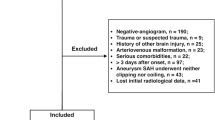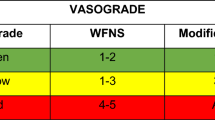Abstract
Introduction
To analyze whether the computed tomography angiography (CTA) spot sign predicts the intraprocedural rupture rate and outcome in patients with aneurysmal subarachnoid hemorrhage (aSAH).
Methods
From a prospective nationwide multicenter registry database, 1023 patients with aneurysmal subarachnoid hemorrhage (aSAH) were analyzed retrospectively. Descriptive statistics and logistic regression analysis were used to compare spot sign-positive and -negative patients with aneurysmal intracerebral hemorrhage (aICH) for baseline characteristics, aneurysmal and ICH imaging characteristics, treatment and admission status as well as outcome at discharge and 1-year follow-up (1YFU) using the modified Rankin Scale (mRS).
Results
A total of 218 out of 1023 aSAH patients (21%) presented with aICH including 23/218 (11%) patients with spot sign. Baseline characteristics were comparable between spot sign-positive and -negative patients. There was a higher clip-to-coil ratio in patients with than without aICH (both spot sign positive and negative). Median aICH volume was significantly higher in the spot sign-positive group (50 ml, 13-223 ml) than in the spot sign-negative group (18 ml, 1–416; p < 0.0001). Patients with a spot sign-positive aICH thus were three times as likely as those with spot sign-negative aICH to show an intraoperative aneurysm rupture [odds ratio (OR) 3.04, 95% confidence interval (CI) 1.04–8.92, p = 0.046]. Spot sign-positive aICH patients showed a significantly worse mRS at discharge (p = 0.039) than patients with spot sign-negative aICH (median mRS 5 vs. 4). Logistic regression analysis showed that the spot sign was an aICH volume-dependent predictor for outcome. Both spot sign-positive and -negative aICH patients showed comparable rates of hospital death, death at 1YFU and mRS at 1YFU.
Conclusion
In this multicenter data analysis, patients with spot sign-positive aICH showed higher aICH volumes and a higher rate of intraprocedural aneurysm rupture, but comparable long-term outcome to spot sign-negative aICH patients.



Similar content being viewed by others
References
Brouwers HB, Backes D, Kimberly WT, Schwab K, Romero JM, Velthuis BK, Klijn CJ, Ogilvy CS, Regli L, Greenberg SM, Rosand J, Rinkel GJ, Goldstein JN (2013) Computed tomography angiography spot sign does not predict case fatality in aneurysmal subarachnoid hemorrhage with intraparenchymal extension. Stroke; J Cereb Circ 44:1590–1594
Brouwers HB, Chang Y, Falcone GJ, Cai X, Ayres AM, Battey TW, Vashkevich A, McNamara KA, Valant V, Schwab K, Orzell SC, Bresette LM, Feske SK, Rost NS, Romero JM, Viswanathan A, Chou SH, Greenberg SM, Rosand J, Goldstein JN (2014) Predicting hematoma expansion after primary intracerebral hemorrhage. JAMA Neurol 71:158–164
Brouwers HB, Greenberg SM (2013) Hematoma expansion following acute intracerebral hemorrhage. Cerebrovasc Dis 35:195–201
Burkhardt JK, Neidert MC, Mohme M, Seifert B, Regli L, Bozinov O (2015) Initial Clinical Status and Spot Sign Are Associated with Intraoperative Aneurysm Rupture in Patients Undergoing Surgical Clipping for Aneurysmal Subarachnoid Hemorrhage. J Neurol Surg A Cent Eur Neurosurg
Del Giudice A, D’Amico D, Sobesky J, Wellwood I (2014) Accuracy of the spot sign on computed tomography angiography as a predictor of haematoma enlargement after acute spontaneous intracerebral haemorrhage: a systematic review. Cerebrovasc Dis 37:268–276
Delgado Almandoz JE, Yoo AJ, Stone MJ, Schaefer PW, Goldstein JN, Rosand J, Oleinik A, Lev MH, Gonzalez RG, Romero JM (2009) Systematic characterization of the computed tomography angiography spot sign in primary intracerebral hemorrhage identifies patients at highest risk for hematoma expansion: the spot sign score. Stroke; J Cereb Circ 40:2994–3000
Demchuk AM, Dowlatshahi D, Rodriguez-Luna D, Molina CA, Blas YS, Dzialowski I, Kobayashi A, Boulanger JM, Lum C, Gubitz G, Padma V, Roy J, Kase CS, Kosior J, Bhatia R, Tymchuk S, Subramaniam S, Gladstone DJ, Hill MD, Aviv RI, group PRSICs (2012) Prediction of haematoma growth and outcome in patients with intracerebral haemorrhage using the CT-angiography spot sign (PREDICT): a prospective observational study. Lancet Neurol 11:307–314
Goldstein JN, Fazen LE, Snider R, Schwab K, Greenberg SM, Smith EE, Lev MH, Rosand J (2007) Contrast extravasation on CT angiography predicts hematoma expansion in intracerebral hemorrhage. Neurology 68:889–894
Guresir E, Beck J, Vatter H, Setzer M, Gerlach R, Seifert V, Raabe A (2008) Subarachnoid hemorrhage and intracerebral hematoma: incidence, prognostic factors, and outcome. Neurosurgery 63:1088–1093, discussion 1093–1084
Hauerberg J, Eskesen V, Rosenorn J (1994) The prognostic significance of intracerebral haematoma as shown on CT scanning after aneurysmal subarachnoid haemorrhage. Br J Neurosurg 8:333–339
Liu X, Rinkel GJ (2011) Aneurysmal and clinical characteristics as risk factors for intracerebral haematoma from aneurysmal rupture. J Neurol 258:862–865
Pegoli M, Mandrekar J, Rabinstein AA, Lanzino G (2015) Predictors of excellent functional outcome in aneurysmal subarachnoid hemorrhage. J Neurosurg 122:414–418
Rosengart AJ, Schultheiss KE, Tolentino J, Macdonald RL (2007) Prognostic factors for outcome in patients with aneurysmal subarachnoid hemorrhage. Stroke; J Cereb Circ 38:2315–2321
Schatlo B, Fung C, Fathi AR, Sailer M, Winkler K, Daniel RT, Bijlenga P, Ahlborn P, Seule M, Zumofen D, Reinert M, Woernle C, Stienen M, Levivier M, Hildebrandt G, Mariani L, Bernays R, Fandino J, Raabe A, Keller E, Schaller K (2012) Introducing a nationwide registry: the Swiss study on aneurysmal subarachnoid haemorrhage (Swiss SOS). Acta Neurochir 154:2173–2178, discussion 2178
Suarez JI, Tarr RW, Selman WR (2006) Aneurysmal subarachnoid hemorrhage. N Engl J Med 354:387–396
van Gijn J, Kerr RS, Rinkel GJ (2007) Subarachnoid haemorrhage. Lancet 369:306–318
Wada R, Aviv RI, Fox AJ, Sahlas DJ, Gladstone DJ, Tomlinson G, Symons SP (2007) CT angiography “spot sign” predicts hematoma expansion in acute intracerebral hemorrhage. Stroke; J Cereb Circ 38:1257–1262
Wilson DA, Nakaji P, Abla AA, Uschold TD, Fusco DJ, Oppenlander ME, Albuquerque FC, McDougall CG, Zabramski JM, Spetzler RF (2012) A simple and quantitative method to predict symptomatic vasospasm after subarachnoid hemorrhage based on computed tomography: beyond the Fisher scale. Neurosurgery 71:869–875
Compliance with ethical standards
Funding
No funding was received for this research.
Conflict of Interest
All authors certify that they have no affiliations with or involvement in any organization or entity with any financial interest (such as honoraria; educational grants; participation in speakers’ bureaus; membership, employment, consultancies, stock ownership, or other equity interest; and expert testimony or patent-licensing arrangements), or non-financial interest (such as personal or professional relationships, affiliations, knowledge or beliefs) in the subject matter or materials discussed in this manuscript.
Ethical approval
All procedures performed in studies involving human participants were in accordance with the ethical standards of the institutional and national research committee and with the 1964 Helsinki Declaration and its later amendments or comparable ethical standards. For this type of study formal consent is not required.
Author information
Authors and Affiliations
Consortia
Corresponding author
Appendix
Appendix
Swiss SOS Study Group Members / Collaborators:
Ali-Reza Fathi, MD, Javier Fandino, MD, Serge Marbacher, MD, Donato D'Alonzo, MD, Hassen Kerkeni, MD, Jahuda Soleman, MD, Daniel Coluccia, MD, Carl Muroi, MD, Hiroki Danura, MD: Department of Neurosurgery, Kantonsspital Aarau; Nicole Schmid, PhD: Neuropsychological Unit, Department of Neurology, Kantonsspital Aarau, Switzerland; Daniel Zumofen, MD, Michel Röthlisberger, MD, Luigi Mariani, MD, Rahael Guzman, MD, PhD: Department of Neurosurgery, Universitätsspital Basel; Andreas U. Monsch, PhD, Stephan Bläsi, PhD: Neuropsychological Unit, Department of Neurology, Universitätsspital Basel, Switzerland; Christian Fung, MD, David Bervini, MD, Jürgen Beck, MD, Andreas Raabe, MD, Johannes Goldberg, MD, Daniel Schöni, MD: Department of Neurosurgery, Inselspital Bern; Jan Gralla, MD: Department of Neuroradiology, Inselspital Bern; Antoinette Zweifel-Zehnder, PhD, Klemens Gutbrod, MD, Rene Müri, PhD: Neuropsychological Unit, Department of Neurology Inselspital Bern, Switzerland; Rodolfo Maduri, MD, Roy Thomas Daniel, MD, Daniele Starnoni, MD, Mahmoud Messerer, MD, Marc Levivier, MD: Department of Neurosurgery, Centre Hospitalier Universitaire Vaudois, Lausanne; Valérie Beaud, PhD: Neuropsychological Unit, Department of Neurology, Centre Hospitalier Universitaire Vaudois, Lausanne, Switzerland; Daniele Valsecchi, MD, Marta Arrighi, MD, Alice Venier, MD, Michael Reinert, MD Dominique E. Kuhlen, MD, Thomas Robert, MD: Department of Neurosurgery, Ente Ospedaliero Cantonale Lugano, Lugano; Stefania Rossi, PhD, Leonardo Sacco, MD: Neuropsychological Unit, Department of Neurology, Ente Ospedaliero Cantonale Lugano, Lugano, Switzerland; Philippe Bijlenga, MD, PhD, Marco Corniola, MD, Karl Schaller, MD: Department of Neurosurgery, Hôpitaux Universitaires de Genève, Geneva; Christian Chicherio, PhD: Neuropsychological Unit, Department of Neurology, Hôpitaux Universitaires de Genève, Geneva, Switzerland; Martin A. Seule, MD, Andrea Ferrari, MD, Astrid Weyerbrock, MD, Martin Hlavica, MD, Jean-Yves Fournier, MD: Department of Neurosurgery, Kantonsspital St.Gallen; Severin Früh, PhD: Neuropsychological Unit, Department of Neurology, Kantonsspital St.Gallen, Switzerland; Bawarjan Schatlo, MD: Department of Neurosurgery, Universitätsmedizin Göttingen, Göttingen, Germany; Jan-Karl Burkhardt, MD, Martin N. Stienen, MD, Emanuela Keller, MD, Luca Regli, MD, Oliver Bozinov, MD, Nicolai Maldaner, MD, Sina Tok, MD, Marian C. Neidert, MD: Department of Neurosurgery, Universitätsspital Zürich, Universität Zürich; Peter Brugger, PhD, Christian Mondadori, PhD: Neuropsychological Unit, Department of Neurology, Universitätsspital Zürich, Universität Zürich, Switzerland.
Rights and permissions
About this article
Cite this article
Burkhardt, JK., Neidert, M.C., Stienen, M.N. et al. Computed tomography angiography spot sign predicts intraprocedural aneurysm rupture in subarachnoid hemorrhage. Acta Neurochir 159, 1305–1312 (2017). https://doi.org/10.1007/s00701-016-3072-1
Received:
Accepted:
Published:
Issue Date:
DOI: https://doi.org/10.1007/s00701-016-3072-1




